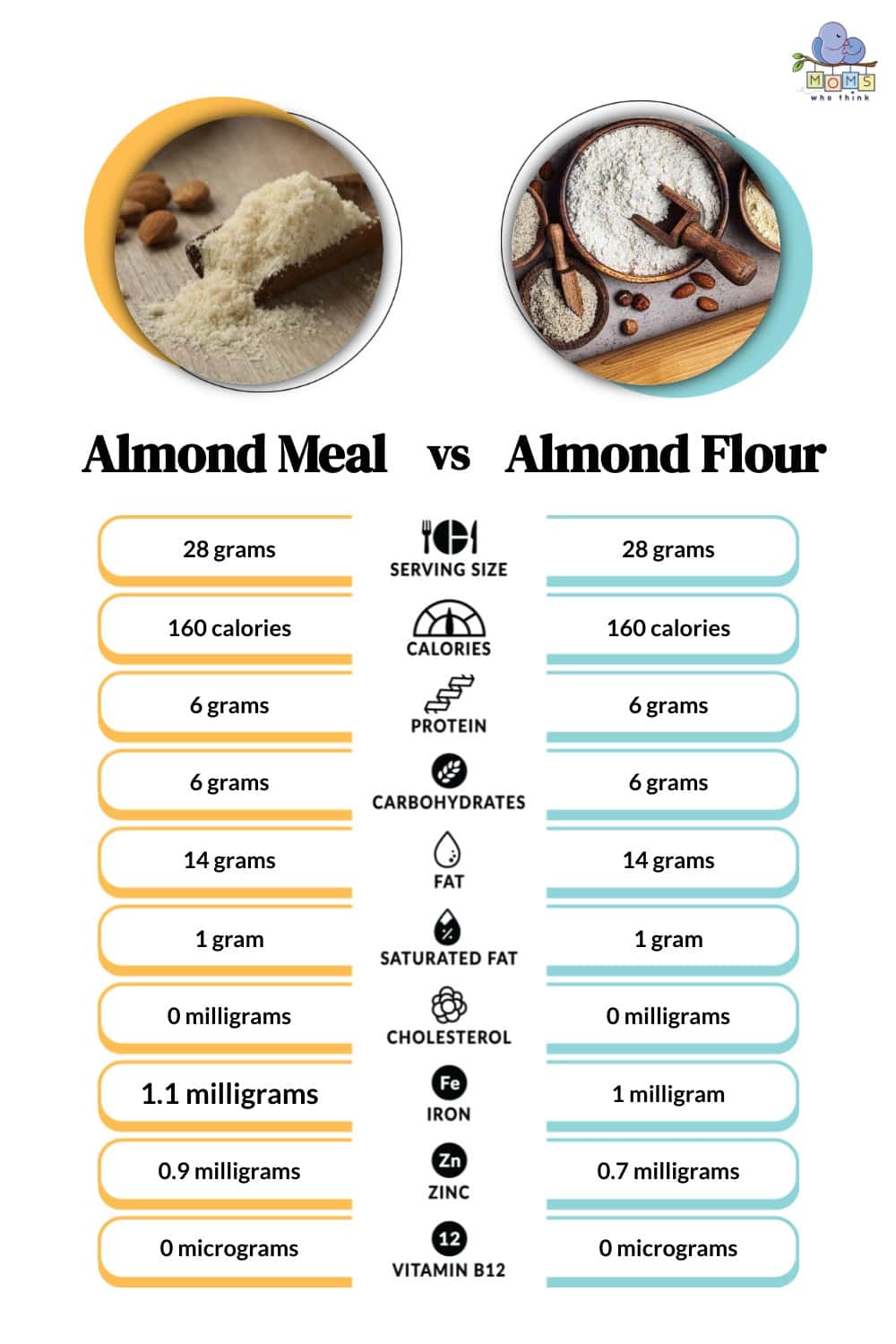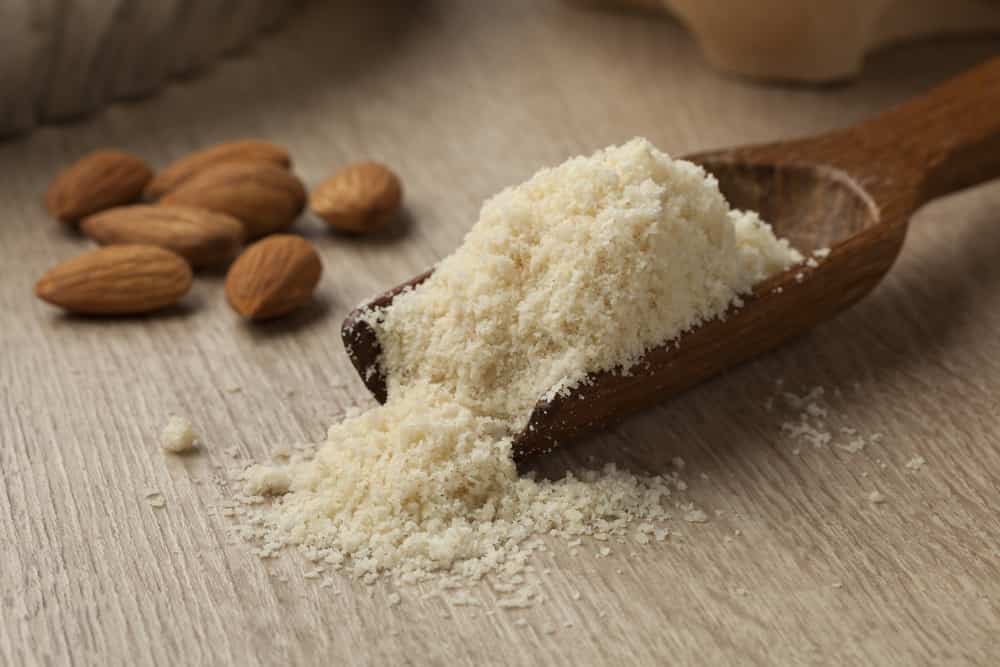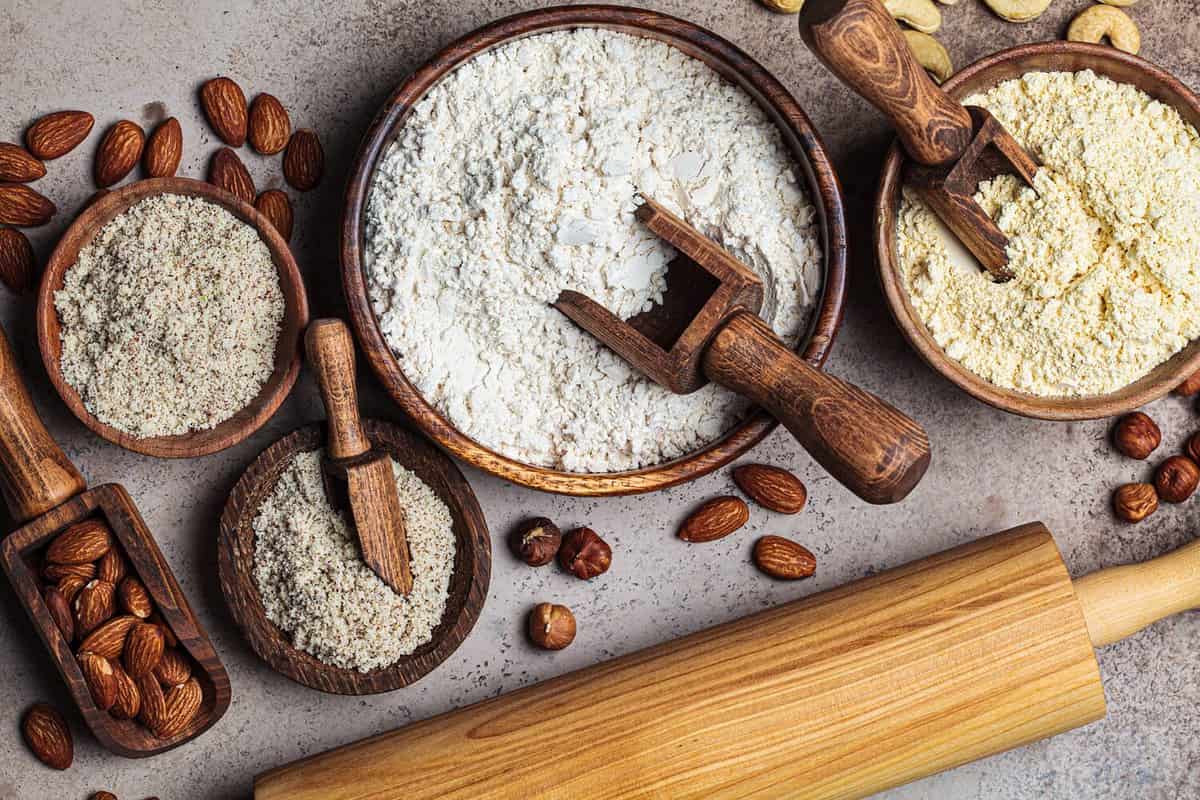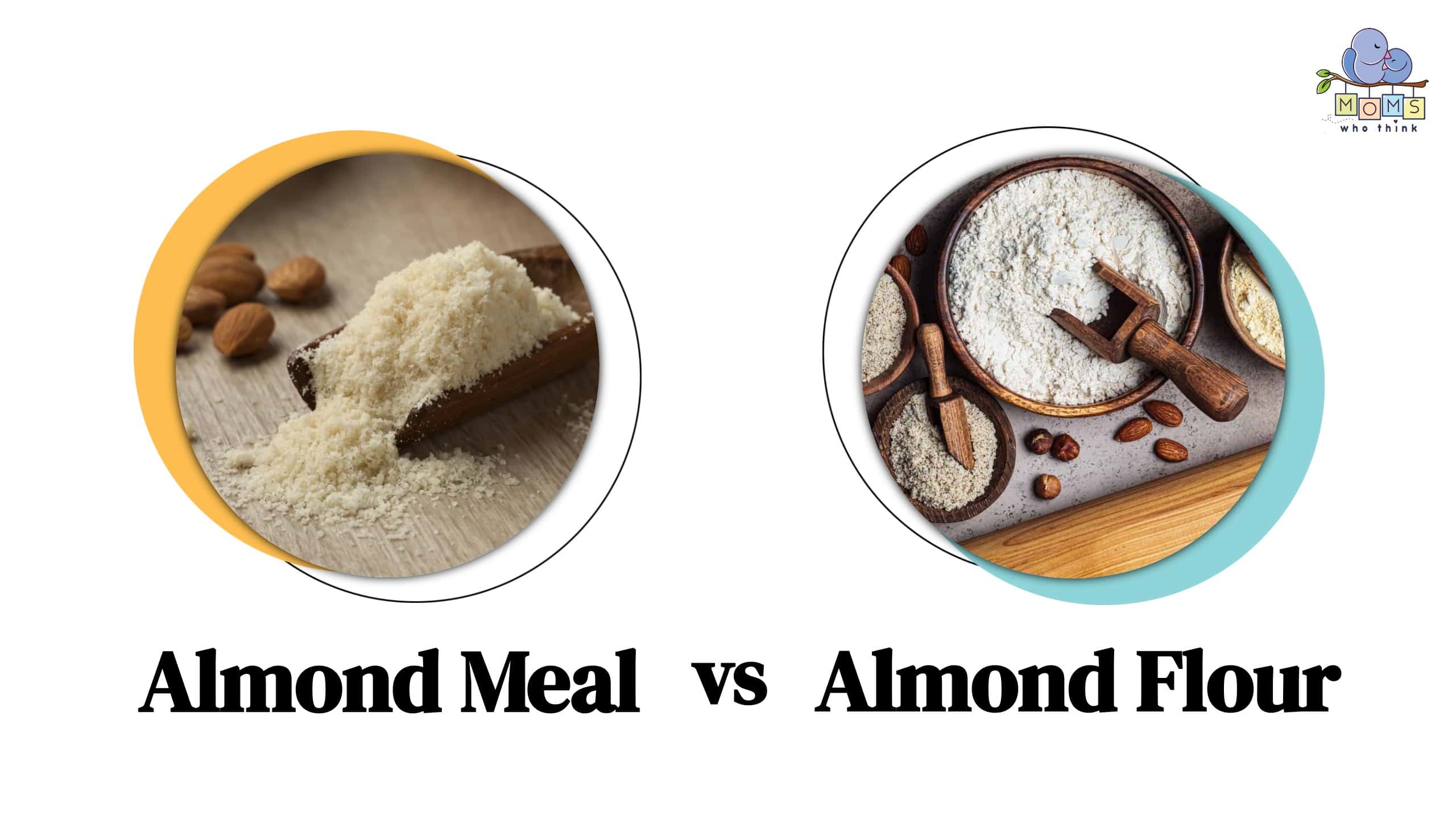Both are made from almonds, but almond meal is a result of unpeeled almonds while almond flour is a result of unpeeled almonds. One has a coarse texture and speckled appearance while the other is much finer and lighter. Though quite similar, their flavor profile is different, and they’re used differently as well. Discover six key differences between almond meal vs. almond flour! Plus, explore a nutritional comparison between the two to determine which may best work for your purposes!
6 Differences & Nutritional Comparison Between Almond Meal vs. Almond Flour
| Almond Meal | Almond Flour | |
|---|---|---|
| Nutrition | Higher in fiber | Lower in fiber |
| Appearance | Speckled | Light and smooth |
| Texture | Coarse; includes almond skins | Fine; no almond skins |
| Uses | Suitable for baked goods with a coarse texture | Gluten-free, fine baked goods |
| Moisture | Higher moisture content | Drier consistency |
| Flavor | Nutty | Mild and neutral |
Almond Meal vs. Almond Flour: Nutrition

When you consider that almond meal and almond flour are both derived from almonds, you realize that their nutritional profile is quite similar. For a serving size of 28 grams, there are 160 calories in both almond meal and almond flour. Both have 6 grams of protein, 6 grams of carbohydrates, and 14 grams of fat. They also both have 1 gram of saturated fat and they’re similar in their iron and zinc content. However, because almond meal incorporates the skin of the almond, it is slightly higher in fiber than almond flour.
Almond Meal vs. Almond Flour: Appearance
When you look at almond meal versus almond flour, you can see a difference in their appearance. Almond flour uses blanched almonds, which end up in a much lighter and finer powder than almond meal. With almond meal, you get a speckled appearance which helps you easily distinguish between the two.
Almond Meal vs. Almond Flour: Texture
Although almond meal is also a powdery flour texture, it’s a bit coarser because it incorporates the skin of raw almonds. Almond flour is very fine and powdery since it only incorporates blanched almonds.
Almond Meal vs. Almond Flour: Uses
When you’re looking to make cookies with a rougher texture, almond meal works perfectly. The same goes for other baked goods like rustic bread. However, if you’re looking to work with more delicate baked goods, almond flour is better suited for those recipes because of its fine texture.
Almond Meal vs. Almond Flour: Moisture
When you work with almond flour, you realize how similar it is to white flour. It’s not just light and fine, but it’s also drier than almond meal. Since almond meal is raw and untouched before it’s blended, it retains all of its healthy oil content, which is why it looks and feels different than its counterpart. It has a slightly higher moisture content as well.
Almond Meal vs. Almond Flour: Flavor
With the skin still on the almonds, almond meal has a much more robust flavor. You can pick up on the nuttiness and slight bitterness of it. With almond flour, you don’t have the impact of the almond skins, so the flavor is a lot more neutral and versatile, though you may also pick up on a subtle sweetness.
Almond Meal vs. Almond Flour: Can You Substitute One for the Other?
Yes and no. Generally, you can use almond meal instead of almond flour and vice versa. They both work well in various baked goods recipes as well as heartier dishes. However, you must remember that they have both subtle and noticeable differences, and knowing when to use each one lends to a tastier result. When you’re going for a more robust meal that celebrates a coarser texture, use almond meal. But when you need your recipe to end up with a smooth, fine finish, stick with almond flour.
Almond Meal Recipe

©Picture Partners/Shutterstock.com
Making almond meal is surprisingly easy. All you need are almonds and a blender! Simply pour raw, unpeeled almonds into your blender and pulse until it forms a powder-like flour. You may need to shake it a bit between pulses to clear out any clumps. Remember, you’re going for a powdery finish so stop blending before you start making it buttery! Once you have your powdery almond meal, what’s next? Here is a fun recipe you can try: chocolate chip and coconut cookies!
You need the following ingredients:
- Almond meal (1 ¼ cups)
- Dark chocolate, chopped (1/4 cup)
- Unsweetened coconut, shredded (1/2 cup)
- Brown sugar (1/3 cup)
- Baking powder (1/2 teaspoon)
- Egg, large (1)
- Coconut oil (3 tablespoons)
- Vanilla extract (1/2 teaspoon)
- Salt (1/4 teaspoon)
Start with a large mixing bowl and pour in your dark chocolate, unsweetened coconut, sugar, salt, baking powder, and almond meal. Use another bowl to whisk your egg until it gets a little bit foamy. To your egg, add the vanilla extract and coconut oil, whisking to combine. Then, pour your wet mixture into your bowl of dry ingredients and mix until you have a good dough. Cover the bowl and place it in your fridge for 20 to 25 minutes.
Preheat your oven to 375 degrees. Then, grease a baking sheet. Take your dough out of the fridge and start to form small dough balls about one inch in diameter. When you place them onto the baking sheet, press them down to form a cookie shape. Bake for about 10 minutes (check for browning edges). Once done, set them aside to cool for a few minutes before enjoying!
Almond Flour Recipe

©Nina Firsova/Shutterstock.com
Just like with almond meal, almond flour requires only almonds along with a blender. The only difference is that you’re not using raw, unpeeled almonds. You’re using blanched almonds instead. Pour them into your blender to achieve a powdery finish. This should take no longer than five minutes. Once you have your almond flour, you can try a new recipe, like the one below.
To make vanilla wafers that are both vegan and gluten-free, you need the following ingredients:
- Gluten-free flour blend (1 ¼ cups)
- Almond flour (1/3 cups)
- Cane sugar, organic (1/3 cup)
- Coconut oil, softened (1/3 cup)
- Chickpea brine (3 tablespoons)
- Almond milk, unsweetened (1 tablespoon)
- Vanilla extract (1 tablespoon)
- Cornstarch (2 tablespoons)
- Sea salt (1/4 teaspoon)
To start, use a mixing bowl to whisk the coconut oil. The consistency should be a bit fluffy before you add the vanilla and sugar. Whisk to combine these ingredients. Next, incorporate the chickpea brine and whisk thoroughly. Once combined, add the almond milk, and whisk again.
Then, add the cornstarch, almond flour, and salt to the mix and whisk again to combine. The final ingredient is the gluten-free flour blend. Switch to a wooden spoon for this part. You’ll end up with a loose batter. Let it chill for about 15 minutes before going back to work with it again.
Meanwhile, preheat your oven to 350 degrees. After your batter has chilled, use two pieces of wax paper underneath and on top to prevent sticking while you roll it out. Then, grab your circle (or any shape!) cookie cutter to cut out the individual wafers.
Prepare your baking sheet with parchment paper. Once they’re all cut out, move them over to your baking sheet. Bake for about 15 minutes until you can see a golden-brown color appear. Let them cool before diving in!
Recipe Card
Looking for more delicious recipes using almond flour? Try these almond flour cookies. Enjoy!
Print
Almond Flour Chocolate Chip Cookies
Ingredients
- 2 cups almond flour
- 1/2 cup unsalted butter, softened
- 1/2 cup granulated sweetener (like erythritol or coconut sugar)
- 1 large egg
- 1 teaspoon vanilla extract
- 1/2 teaspoon baking soda
- 1/4 teaspoon salt
- 1 cup sugar-free or dark chocolate chips
Instructions
- Preheat your oven to 350°F (175°C) and line a baking sheet with parchment paper.
- In a large bowl, cream together the softened butter and granulated sweetener until light and fluffy.
- Add the egg and vanilla extract, mixing until well combined.
- In a separate bowl, whisk together the almond flour, baking soda, and salt.
- Gradually add the dry ingredients to the wet ingredients, mixing until a cookie dough forms.
- Fold in the chocolate chips.
- Using a cookie scoop or your hands, form dough balls and place them on the prepared baking sheet, leaving enough space between each.
- Bake in the preheated oven for 10-12 minutes or until the edges are golden brown. Keep in mind that almond flour cookies may still be soft when they come out of the oven but will firm up as they cool.
- Allow the cookies to cool on the baking sheet for a few minutes before transferring them to a wire rack to cool completely.

